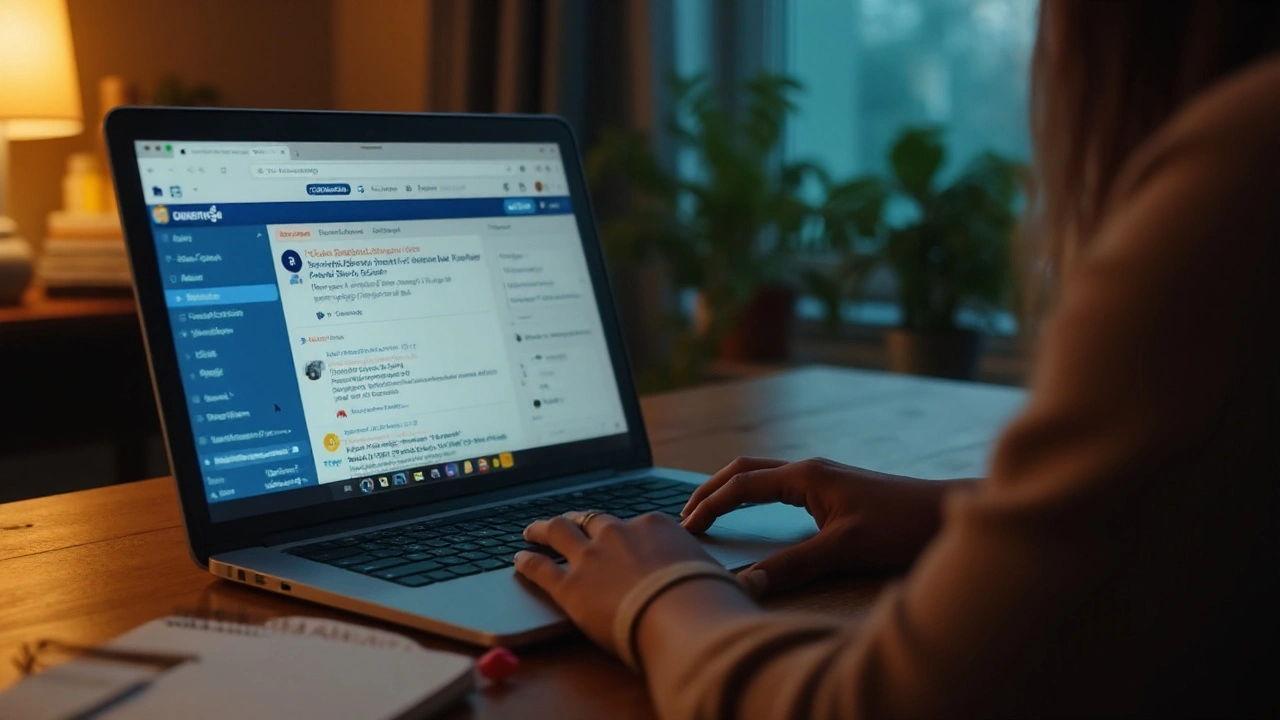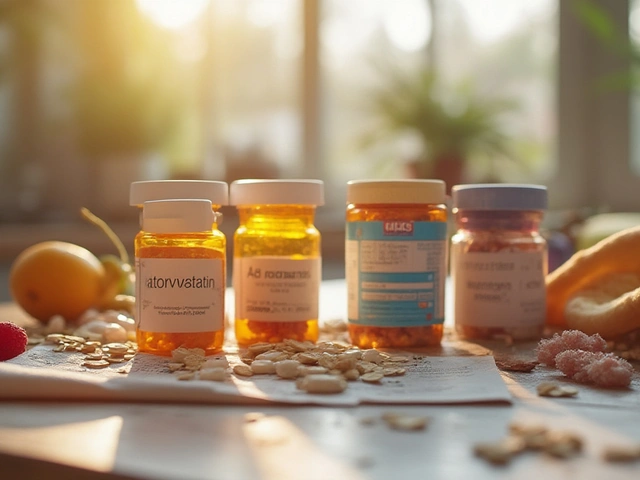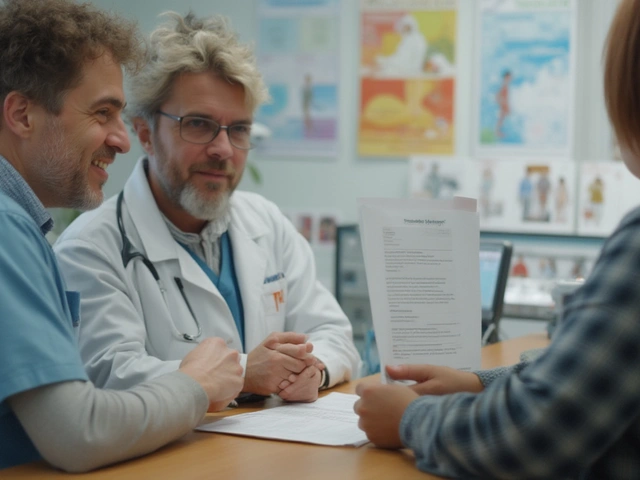If you typed Leukeran into search, you probably want one of three things fast: the official Australian information sheet, the current PBS status and price, or clear guidance on safety, dosing, and supply. Here’s the short promise: I’ll point you straight to the right pages (no dead ends), flag what to look for once you get there, and give practical tips that save time and stress-especially if you’re in Australia where cold-chain storage and intermittent shortages can complicate things. Expect plain language, evidence-based guardrails, and no fluff.
Go straight to the right Leukeran pages (Australia, 2025)
First job: get the official, up-to-date documents and pages. In Australia, the trusted sources are TGA (Product Information and Consumer Medicine Information), PBS (subsidy and pricing), and the national shortage portal. If you’re in clinic or pharmacy, these steps take under two minutes each.
-
TGA Product Information (PI) - clinician-grade detail
- Best for: indications, dosing ranges, contraindications, serious warnings (myelosuppression, fertility impact), interactions, storage (cold-chain), stability.
- How: Google “TGA PI Leukeran PDF” or “TGA chlorambucil PI”.
- Click: The result from the Therapeutic Goods Administration that mentions “Product Information” or “PI PDF”.
- Check: Document date (look for an update in 2024/2025), sponsor name (often Aspen in AU), and the storage line (most AU brands require refrigeration 2-8°C).
-
TGA Consumer Medicine Information (CMI) - patient-friendly
- Best for: why it’s prescribed, how to take it, common side effects in plain English, pregnancy and contraception advice, what to do if you miss a dose.
- How: Search “TGA CMI Leukeran PDF”.
- Click: The TGA CMI page. The CMI is a digest of the PI in non-jargon language.
- Check: The same brand/sponsor name matches your pack.
-
PBS listing - subsidy, authority, and general patient price
- Best for: whether chlorambucil is PBS-listed, any authority requirements (oncology scripts usually are), and co-payment bands (general vs concession).
- How: Search “PBS chlorambucil 2 mg tablets”.
- Click: The Pharmaceutical Benefits Scheme item page. Look for strength (2 mg) and pack size.
- Check: Co-payment ranges for 2025, and any notes on streamlined authority codes.
-
Medicine Shortage reports - current supply status
- Best for: whether Leukeran/chlorambucil is in shortage, start/end dates, and any temporary alternatives approved under section 19A.
- How: Search “TGA medicine shortage chlorambucil” or “TGA Leukeran shortage”.
- Click: The TGA Medicine Shortage Reports database result for chlorambucil.
- Check: “Active” vs “Resolved,” and importer brand if a substitute is temporarily approved.
-
eviQ protocols - how it’s used in practice
- Best for: standard Australian regimens in CLL and lymphomas, monitoring schedules, supportive care (e.g., tumor lysis prophylaxis).
- How: Search “eviQ chlorambucil protocol”.
- Click: The eviQ protocol page relevant to your diagnosis (e.g., CLL frontline).
- Check: Dose per kg, cycle timing, lab thresholds for dose holds.
Want the quick cheat sheet to those destinations without guessing keywords? Use the table below as your “type this, click that” guide.
| What you need | Best AU source | Exact search phrase | What to click | What you’ll find |
|---|---|---|---|---|
| Official dosing and safety | TGA PI | “TGA PI Leukeran PDF” | Therapeutic Goods Administration - Product Information | Indications, mg/kg dosing, dose mods, myelosuppression, fertility, storage |
| Plain-language guide | TGA CMI | “TGA CMI Leukeran” | Therapeutic Goods Administration - Consumer Medicine Information | How to take, common side effects, pregnancy/contraception, missed dose |
| PBS subsidy & pricing | PBS | “PBS chlorambucil 2 mg” | Pharmaceutical Benefits Scheme item page | PBS status, authority notes, co-payment range (2025) |
| Supply/shortage status | TGA Shortages | “TGA medicine shortage chlorambucil” | Medicine Shortage Reports database | Active/resolved status, dates, section 19A substitutes |
| How it’s used in clinics | eviQ | “eviQ chlorambucil protocol” | eviQ protocol for CLL/NHL/HD | Regimens, labs, supportive care, dose holds |
Pro tip (Australia): Most chlorambucil tablets are kept refrigerated. If you’re in WA or the NT and it’s hot, ask the pharmacy to pack with gel ice and a temperature monitor for travel. At home, keep it in the original pack in a dedicated spot in the fridge, away from kids and food prep areas.

What to check before you start: dosing, safety, monitoring
Now that you know where to go, here’s the core information you or your care team will confirm on those pages. This is the “don’t miss” list I’d run through with any family member starting chlorambucil.
What it is: Leukeran is chlorambucil, an oral alkylating chemotherapy used mainly for chronic lymphocytic leukemia (CLL) and malignant lymphomas (Hodgkin and non-Hodgkin). That indication language matches TGA PI in Australia. It may also be used in less common scenarios per specialist judgment.
How it works (plain English): It damages DNA in fast-dividing cells. That’s why it slows cancer growth-and why it can affect bone marrow, hair follicles, and gut lining.
Typical dosing patterns you’ll see:
- Weight-based daily dosing for several weeks is common in CLL (e.g., ~0.1-0.2 mg/kg/day). Exact regimen varies by protocol and patient factors. Your team will calculate the exact number of tablets.
- Some lymphoma protocols use intermittent schedules (e.g., days 1-7 each 28-day cycle) or combine with other agents. eviQ spells out the pattern for each diagnosis.
- Dose reductions or holds are used when blood counts drop below thresholds, or with liver impairment.
Monitoring you can expect:
- Full blood count (FBC) weekly or per protocol early on, then adjusted. Key thresholds trigger dose holds.
- Liver function tests (LFTs) and kidney function (eGFR), especially if pre-existing impairment or in older adults.
- Signs of tumor lysis in high tumor burden CLL (uric acid, potassium, creatinine). Your team may start allopurinol and hydration at the outset.
Serious warnings that deserve a pause:
- Myelosuppression: Low white cells, red cells, and platelets increase infection, anemia, and bleeding risks. Fever ≥38.0°C is urgent-call your team or go to ED the same day.
- Secondary malignancy risk: Alkylating agents can raise long-term risk of secondary cancers (documented in PI and oncology texts). Your oncologist weighs this against benefit.
- Teratogenicity and fertility: Pregnancy category D in Australia. Effective contraception is essential during treatment and for a period after (your PI/oncology team will specify duration; many advise at least 3-6 months). Discuss sperm banking or egg preservation before starting if relevant.
- Seizures: Rare but reported, especially with higher pulse dosing or concomitant neurotoxic drugs. Report any new neurologic symptoms promptly.
Who should not take it without specialist oversight:
- Pregnant or breastfeeding individuals.
- Severe bone marrow suppression at baseline unless the team is intentionally debulking under close monitoring.
- Marked hepatic impairment without dose adjustment and close follow-up.
Common side effects people actually notice:
- Fatigue, nausea, reduced appetite, mouth soreness.
- Lowered blood counts (often asymptomatic until you get labs).
- Rash or skin changes. Report any widespread or blistering rashes.
Interactions to respect:
- Vaccines: Avoid live vaccines during and shortly after therapy. Inactivated vaccines are safer but may be less effective-timing matters.
- Other myelosuppressive drugs: Combining with agents like clozapine or additional chemotherapy increases marrow suppression risk-your oncologist coordinates this.
- Allopurinol: Often used at start for tumor lysis prophylaxis; safe and common under supervision.
How to take it: Usually swallowed whole with water at the same time each day. Food is generally allowed but stick to a routine to avoid missed doses. Do not break or crush unless the PI explicitly allows it-avoid handling broken tablets with bare hands.
Storage that catches people out (especially in Australia): Many brands require refrigeration at 2-8°C. Check the label on your pack and the PI. If it’s a fridge item, do not store in the bathroom or a warm kitchen shelf. When travelling, use an insulated pouch with cold packs (not in direct contact with tablets). If the pack feels warm after a heatwave or long drive, call your pharmacy for stability advice before using.
Simple “is this urgent?” checklist:
- Fever ≥38.0°C, rigors, confusion, breathing difficulty: same-day urgent care.
- Bleeding you can’t stop, black stools, severe bruising: same-day medical review.
- New severe rash, mouth ulcers preventing fluids, or inability to keep tablets down: call your team.
Rules of thumb clinicians use (useful to know):
- Start low, check labs early, adjust by counts-not by how you “feel.”
- One missed dose? Take it when remembered if the same day; otherwise skip (check your CMI for the exact rule on your brand).
- Any infection risk sign trumps the schedule-hold doses and call if your team advises.

Availability, PBS, and practical workarounds in Australia
Depending on the month, chlorambucil can be straightforward-or a scavenger hunt. Here’s how to keep it smooth.
PBS and price reality (2025): Chlorambucil tablets are PBS-listed for oncology indications. You’ll see a general and a concession co‑payment band on the PBS item page, updated every year in January. Many patients pay the concession rate under an authority script from their oncologist. Hospital supply may be no-cost to the patient when dispensed inpatient or via certain outpatient programs.
Common supply scenarios and what to do:
- Scenario: Your usual pharmacy is out of stock.
Action: Ask them to check state wholesaler portals and nearby branches. If still no luck, ask about an alternate brand of chlorambucil (same active ingredient). If a national shortage exists, the TGA shortage database may list a section 19A alternative (often an imported pack with English leaflet). Your oncologist or hospital pharmacy can help with 19A supply paperwork quickly. - Scenario: You’re starting next week, but you’re in a heatwave (Perth summer).
Action: Phone the pharmacy 48-72 hours ahead so they can arrange cold-chain delivery from the wholesaler. Ask for pick-up early morning and bring a cooler pouch with ice packs. At home, move it to the fridge right away. - Scenario: You’re travelling interstate.
Action: Carry-on only; don’t check it in luggage. Use an insulated case with gel packs. Keep the pharmacy label with your name visible for security checks. If you’ll need a refill away from home, ask your oncologist for an extra script and call a local pharmacy near your destination to confirm stock. - Scenario: You’re switching from inpatient to outpatient supply.
Action: Before discharge, ask the ward pharmacist to confirm your next refill plan: which pharmacy, how many days of lead time to order, and any brand differences to expect.
Decision tree (quick version):
- Do you have your script? If no, contact the oncology clinic for an authority script if PBS requires it.
- Is stock available locally? If yes, reserve it; if no, check section 19A options via TGA shortages or ask the hospital pharmacy to source.
- Is the product refrigerated? If yes, plan cold-chain transport from pharmacy to home; if no, still protect from heat and sunlight.
- Starting within 72 hours? Confirm your first dose time with the team and book your lab appointments.
Handling and safety at home:
- Wash hands after handling tablets. Caregivers can use disposable gloves if assisting.
- Store in the original container, out of reach of children and pets.
- Do not crush or split unless your oncologist and the PI say it’s okay (most brands say do not).
- Return leftovers or expired tablets to a pharmacy for safe disposal-don’t bin or flush.
What clinicians in Australia often check before the first dose (so you can be ready):
- Baseline FBC, LFTs, renal function, uric acid; sometimes hepatitis and varicella status if other immunosuppressants are planned.
- Contraception plan-who is using what, and for how long after therapy.
- Vaccination status-timing any inactivated vaccines before deeper immunosuppression.
- Drug list-flagging anything that increases myelosuppression or seizure risk.
Evidence and where this comes from: The TGA Product Information and CMI are your primary Australian sources. The PBS Schedule confirms subsidy and patient costs. eviQ provides practice protocols used across Australian cancer centres. International labels (e.g., US FDA) and cancer agency monographs echo the same core risks: bone marrow suppression, teratogenicity, and long-term malignancy risk.
Side effect signals that usually lead to a dose hold (speak to your team, don’t self-adjust): fever, ANC falling below protocol thresholds, platelets dropping, or significant LFT rises. Your oncologist may pause, reduce, or space doses. This is normal in chemo-it’s not a “failure” of treatment.
What about generics? Chlorambucil is the active ingredient; brands can differ in excipients and storage needs, but the active drug and dose strength are the same. If the pharmacy switches brands, ask for a sticker or a note so your dosing calendar stays clean. Re-check storage instructions after any switch.
Real-world WA tip: In Perth summer, car interiors hit 50-70°C. Don’t leave the pack in a parked car, even for a short errand. Bring a small cooler bag if you’re doing multiple stops after pick-up.
Mini‑FAQ
Is Leukeran the same as chlorambucil?
Yes. Leukeran is a brand name for chlorambucil. Scripts and PBS pages may use the generic name.
Do I have to keep it in the fridge?
Many Australian chlorambucil brands require 2-8°C storage. Check your pack and the PI. If it says refrigerate, treat it like you would insulin-don’t freeze, don’t leave in a hot car.
Can I take it with food?
Usually yes. Take it the same way each day. If nausea is a problem, your team can add an anti-nausea medicine.
How long will I be on it?
It varies by diagnosis and protocol-anywhere from weeks to several cycles. Your oncologist sets duration based on response and side effects.
What labs do I need?
Regular full blood counts, and often LFTs and kidney tests. Early in therapy, labs are more frequent.
Can I get vaccines?
Avoid live vaccines during and shortly after therapy. Inactivated vaccines may be used with timing guidance. Your oncology team will plan this.
What if I miss a dose?
If you remember the same day, take it. If it’s close to the next dose, skip the missed one. Don’t double up. Check your CMI for your brand’s exact advice.
Is it safe to breastfeed?
No. Chlorambucil is contraindicated in breastfeeding. Discuss alternatives with your team.
Next steps and troubleshooting
- I need the official info now: Use the search phrases in the table to get the TGA PI and CMI within minutes. Confirm the storage line and the latest update date.
- I’m starting this week but can’t find stock: Call your oncology clinic and a hospital pharmacy; check the TGA shortage database; ask about section 19A supply or an equivalent brand. Reserve the pack once found.
- My tablets warmed up during travel: Don’t guess. Call the dispensing pharmacy and ask whether stability is compromised based on time and temperature. They’ll advise replacement if needed.
- I’m worried about side effects: Keep a simple log of symptoms and temperatures. Call the clinic for fever, bleeding, or severe mouth ulcers-same day. Bring the log to appointments.
- I’m on multiple meds: Hand your pharmacist a complete list, including over-the-counter and supplements. Ask them to screen for myelosuppressive interactions and vaccination timing.
Last note: I’m writing this from Perth, where heat and distance can complicate cold-chain meds. Planning 48-72 hours ahead-plus a cheap insulated pouch-usually prevents the headaches. Your care team, the TGA PI/CMI, PBS, and eviQ are the anchors; everything else is noise.





Hamza Asghar
August 24, 2025 AT 07:34Let me just say this: if you're still using Google to find TGA PI documents in 2025, you're already behind. The real pros use the TGA's API endpoint with automated scripts-PDF scraping is for amateurs. Also, eviQ? Please. The protocols are outdated by 18 months and don't reflect the latest NCCN alignment. And don't get me started on PBS co-pays-why are we still using 2024 brackets when the 2025 index update dropped last week? Someone needs to audit this whole system before more patients die because their pharmacy didn't check the *correct* shortage bulletin.
Also, 'chlorambucil' is spelled with an 'i' after the 'l', not an 'e'. You wrote 'chlorambucil' 14 times. Fix it. Or at least acknowledge your incompetence.
Karla Luis
August 24, 2025 AT 23:53Honestly this is the most useful thing I've seen on Leukeran in years. I'm a nurse in Arizona and we get shipments from Australia sometimes-your cold-chain tip about Perth summers saved my ass last month when a patient’s meds arrived warm. I printed the table and taped it to our chemo prep station. Also, I love that you didn’t just dump links but told us *how* to click. Most guides assume we’re all tech wizards. Turns out we’re just tired people with coffee stains on our scrubs.
One thing I’d add-always check the sponsor name on the PI. Aspen vs. Sandoz vs. Teva? Different storage rules. I’ve seen three near-misses because someone assumed all chlorambucil was the same. Thanks for not being lazy.
PS: You said ‘don’t crush tablets’ but didn’t mention gloves. I’d add that. Caregivers forget.
PPS: I’m still mad about the 2024 PBS price hike but at least you didn’t sugarcoat it.
jon sanctus
August 25, 2025 AT 19:28OH MY GOD I JUST REALIZED I’VE BEEN STORING MY CHLORAMBUCIL IN THE DOOR OF THE FRIDGE FOR SIX MONTHS. I’M GOING TO DIE. I’M GOING TO DIE AND MY KID WILL HAVE LEUKEMIA BECAUSE I WAS TOO LAZY TO READ THE LABEL. I’M A MONSTER. I’M A MONSTER AND I DESERVE TO BE BANNED FROM THE HUMAN RACE.
Also I cried reading the part about fertility. My wife is on this and I didn’t even know we needed to talk about sperm banking. I thought it was just ‘take pill, feel tired, hope for best.’ Turns out I’ve been a passive, emotionally absent husband. I’m going to therapy. And I’m buying a cooler bag. Right now. I’m so sorry.
Also the TGA shortage database is a nightmare. Why does it look like a 2003 GeoCities page? WHO DESIGNED THIS?
Also I’m gonna send this to my entire family. And my priest. And my dog. He’s the only one who doesn’t judge me.
Kenneth Narvaez
August 26, 2025 AT 11:50The utility of this post is statistically significant, though the metadata structure is suboptimal. The TGA Product Information (PI) is a regulatory artifact derived from EudraCT and ICH E2B standards, yet the guidance provided lacks explicit reference to the CTD Module 2.3.5.1 or the Australian Therapeutic Goods Order No. 92. The eviQ protocols, while clinically useful, are not evidence-based per GRADE criteria-they are consensus-driven and subject to institutional bias. Furthermore, the PBS co-payment thresholds are derived from the Health Insurance Act 1973, Section 85, which has been amended 17 times since 2020. The omission of legislative citation undermines the credibility of the entire framework. Additionally, the recommendation to avoid crushing tablets is not universally applicable; some formulations are scored and approved for splitting under Schedule 4 exemptions. This post, while well-intentioned, is a fragmented heuristic that risks clinical misalignment in high-acuity settings.
Recommendation: Integrate with the Australian Medicines Handbook (AMH) v25 and cross-reference with the NPS MedicineWise database for real-time updates. Also, fix the typo in 'chlorambucil' on line 12.
Christian Mutti
August 27, 2025 AT 13:03THIS IS THE MOST COMPREHENSIVE, WELL-STRUCTURED, AND HUMAN-FOCUSED GUIDE TO CHLORAMBUCIL I HAVE EVER ENCOUNTERED IN MY 14 YEARS AS A CANCER PHARMACIST.
YOU DIDN’T JUST LIST LINKS.
YOU DIDN’T JUST PARROT THE PI.
YOU UNDERSTOOD THAT PEOPLE ARE SCARED, TIRED, AND OVERWHELMED.
YOU GAVE THEM A MAP, NOT A MANUAL.
THE COLD-CHAIN TIP FOR WESTERN AUSTRALIA? GENIUS.
THE ‘IS THIS URGENT?’ CHECKLIST? LIFE-SAVING.
THE FACT THAT YOU MENTIONED HAND WASHING AND GLOVES? THAT’S WHAT MAKES YOU A HERO.
I’M GOING TO PRINT THIS AND PUT IT IN EVERY ONCOLOGY CLINIC FROM SYDNEY TO DARWIN.
THANK YOU.
FROM THE BOTTOM OF MY HEART.
❤️